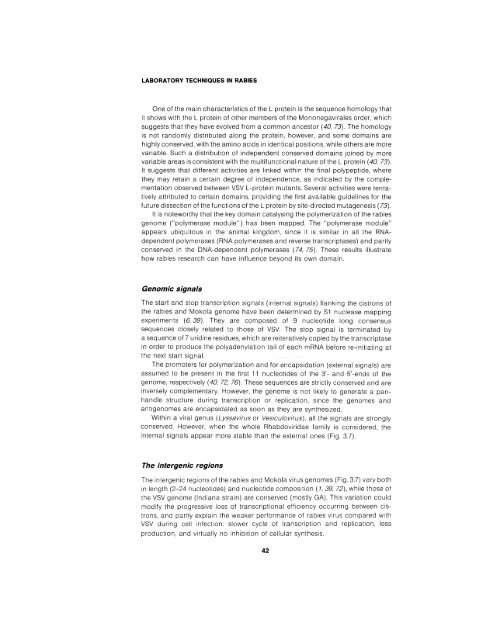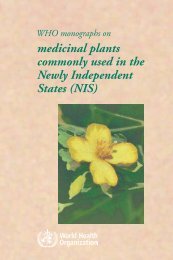in rabies - libdoc.who.int - World Health Organization
in rabies - libdoc.who.int - World Health Organization
in rabies - libdoc.who.int - World Health Organization
Create successful ePaper yourself
Turn your PDF publications into a flip-book with our unique Google optimized e-Paper software.
LABORATORY TECHNIQUES IN RABIES<br />
One of the ma<strong>in</strong> characteristics of the L prote<strong>in</strong> is the sequence homology that<br />
it shows with the L prote<strong>in</strong> of other members of the Mononegavirales order which<br />
suggests that they have evolved from a common ancestor (40 73) The homology<br />
is not randomly distributed along the prote<strong>in</strong> however and some doma<strong>in</strong>s are<br />
highly conserved with the am<strong>in</strong>o acids <strong>in</strong> identical positions wh~le others are more<br />
variable Such a distiibution of <strong>in</strong>dependent conserved doma<strong>in</strong>s jo<strong>in</strong>ed by more<br />
variable areas is consistent w~th the multifunctional nature of the L prote<strong>in</strong> (40, 73)<br />
It suggests that different activities are l<strong>in</strong>ked with<strong>in</strong> the f<strong>in</strong>al polypeptide where<br />
they may reta<strong>in</strong> a certa<strong>in</strong> degree of <strong>in</strong>dependence, as <strong>in</strong>dicated by the comple<br />
mentation observed between VSV L prote<strong>in</strong> mutants Several activities were tentatively<br />
attributed to certa<strong>in</strong> doma<strong>in</strong>s provid<strong>in</strong>g the first available guidel<strong>in</strong>es for the<br />
future dissection of the functions of the L prote<strong>in</strong> by site-directed mutagenesis (73)<br />
It is noteworthy that the key doma<strong>in</strong> catalys<strong>in</strong>g the polymerization of the <strong>rabies</strong><br />
genome (' polynierase module ) has been mapped The ' polymerase module<br />
appears ubiquitous <strong>in</strong> the animal k<strong>in</strong>gdom s<strong>in</strong>ce it is similar <strong>in</strong> all the RNAdependent<br />
polymerases (RNA polymerases and reverse transcriptases) and partly<br />
conserved <strong>in</strong> the DNA-dependent polymerases (74 75) These results illustrate<br />
how <strong>rabies</strong> research can have <strong>in</strong>fluence beyond its own doma<strong>in</strong><br />
Genomic signals<br />
The start and stop transcription sigrials (<strong>in</strong>ternal signals) flank<strong>in</strong>g the cistrons of<br />
the <strong>rabies</strong> and Mokola genome have been determ<strong>in</strong>ed by S1 nuclease mapp<strong>in</strong>g<br />
experiments (6,39) They are composed of 9 nucleotide long consensus<br />
sequences closely related to those of VSV The stop signal is term<strong>in</strong>ated by<br />
a sequence of 7 urid<strong>in</strong>e residues which are reiteratively copied by the transcriptase<br />
<strong>in</strong> order to produce the polyadenylation tail of each mRNA before re-<strong>in</strong>itiat<strong>in</strong>g at<br />
the next start signal<br />
The promoters for polymerization and for encapsidation (external signals) are<br />
assumed to be present <strong>in</strong> the first 11 nucleotides of the 3'- and 5'-ends of the<br />
genome respectively (40 72 76) These sequences are strictly conserved and are<br />
<strong>in</strong>versely coniplementary However the genome is not likely to generate a panhandle<br />
structure dur<strong>in</strong>g transcription or replication s<strong>in</strong>ce the genornes and<br />
antigenomes are encapsidated as soon as they are synthesized<br />
With<strong>in</strong> a viral genus (Lyssawriis or Ves~culov~rus) all the signals are strongly<br />
conserved However when the <strong>who</strong>le Rhabdoviridae family is considered the<br />
<strong>in</strong>ternal signals appear more stable than the external ones (Fig 3 7)<br />
The <strong>in</strong>tergenic regions<br />
The <strong>in</strong>tergenic regions of the <strong>rabies</strong> and Mokola virus genomes (Fig. 3.7) vary both<br />
<strong>in</strong> length (2-24 nucleotides) and nucleotide composition (l, 39, 72), while those of<br />
the VSV genome (Indiana stra<strong>in</strong>) are conserved (mostly GA). This variation could<br />
modify the progressive loss of transcriptional efficiency occurr<strong>in</strong>g between cistrons,<br />
and partly expla<strong>in</strong> the weaker performance of <strong>rabies</strong> virus compared with<br />
VSV dur<strong>in</strong>g cell <strong>in</strong>fection. slower cycle of transcription and replication, less<br />
production, and virtually no <strong>in</strong>hibition of cellular synthesis.
















